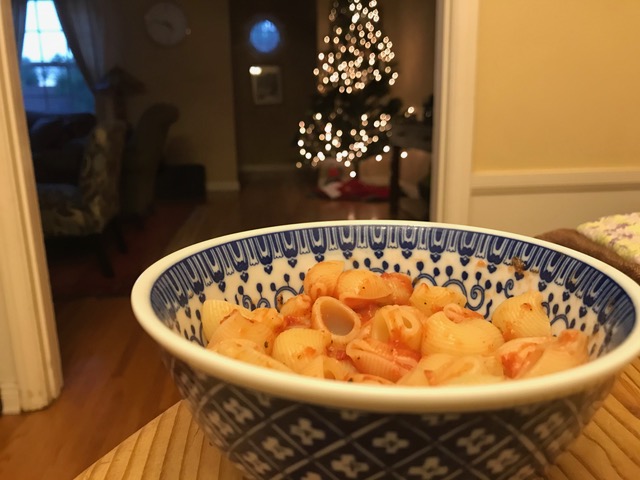Every winter of my childhood when the wind whipped outside and the falling rain created puddles in the sidewalks, I would trudge through the door depleted from my two-block walk home from school.
In the kitchen on those dreary days, my mom would spend the day cooking the most life-giving bowl of pasta to fill me back up. The noodles were usually penne, lightly colored with red sauce that tickled the tip of the tongue with sweetness followed by notes of tanginess. There was magic in that bowl of pasta. And the secret of its power was closely guarded as a sacred family recipe with roots stretching back to the old world.
The secret was whispered from one great-great relative to another and smuggled across war-torn borders and oceans of migration to our suburban home where its magic wrapped me in warmth. So you can imagine my disappointment, when I found out the recipe—like this memory—was a big, fat lie.
It turns out the magic came from a can. Specifically, Hunt’s tomato ketchup—the premium kind only, please.
“I will show you how to make it,” said my mom. “So you can know.”
I was in my 20s and ready, in her eyes, to have this old family recipe transmitted to me.
Boil penne noodles. Open can. Pour sauce over cooked noodles. Have ready for when her overly-dramatic daughter falls through the door. Sure, my mom added a pinch of this and a dash of that, but she will swear to you that the origins of this recipe survived in her memory bank through wars. Okay, just one war that lasted many years in Vietnam that forced our family to cross perilous waters to a refugee camp in Malaysia.
That’s the funny part of human memory and traditions—we all believe what we want as inalienable truth. During the holiday season, especially, our daily lives can get consumed with habits and traditions passed down from our parents and grandparents. In the intersection of memory, manufactured traditions and commercialized holidays, how do we decide what traditions are real and worthy of carrying on?
The holidays bring out a complicit stretching of truth, that with time can become memory and tradition. It’s a time to tell stories about a man with eight reindeer, who watches children and brings toys to the good. And it’s a time, more than any other, that we willingly suspend disbelief. My childhood home did not have a chimney, how did Santa get in? I asked my parents one Christmas morning when I woke to a stocking full of trinkets.
He opened the window, my dad said. “Yes! Of course!” I exclaimed not thinking to question how Santa got through the window’s metal security bars.
Every tradition needs a willing transmitter and transmitee.
After the eggnog haze clears, it’s okay to take traditions off of their hallowed high shelf, examine their origins, and question their roles in your busy lives.
The pressure to find a good family photographer starts as early as August and peaks in early December when inevitably, someone posts on social media in all caps a desperate search for a good photographer for their family’s holiday greeting card. Those cards with pictures of smiling people in perfect lighting was originally the idea of Louis Prang, who—surprise!—owned a printing business and needed to create a market for his business.
Let’s get real here: Taking those family photos is just as fun as going to the DMV without an appointment—someone always ends up crying or fighting. But those cards come every year like the OG Instagram, showing a filtered snapshot of an otherwise complex life. Our family stopped sending out holiday cards a few years ago. We decided the race to get them sent out didn’t make sense to us. The absence of this tradition in our life has yielded a little more time, a little less stress.
Sorry, not sorry, Louis Prang.
Some traditions have commercial starts while others start from necessity.
Fifteen years ago, Helene Skantzikas, a food blogger, and her family had almost finished decorating their Christmas tree when they noticed one important finishing touch was missing—the star on top. The problem was they didn’t have one, so they put a hedgehog up there. Not just any hedgehog, a plush one named Hérisson, whose origins trace back to France. Every Christmas since, the hedgehog has reigned.
“I think he’s happy up there,” said Skantzikas. “But hilariously, people who see Hérisson have varied reactions, including really relating to him with an ‘ouch!’”
Out of necessity came a family tradition with a story that may continue to evolve. What version of Hérisson’s story will Skantzikas’ 8-year-old son tell to his children? Only time can tell.
Let’s go back to my mom’s steaming bowl of pasta, which she said she cooked even in the shack of a refugee camp.
After the fall of Saigon to Communist power in 1975, millions of Vietnamese families fled the country, including mine. We settled temporarily in Malaysia while waiting for our permanent homes in the United States. Conditions were harsh and overcrowded, but one of the highlights, my mom said, was receiving care packages from foreign agencies including baby formula for me and, yes, cans of Hunt’s premium tomato ketchup.
The magic was real even if the story was not.
Recently, my mom made the pasta dish again and presented it to my kids, ages 7 and 4. The way I saw it, I had a choice with my new level of awareness: To continue to string the line of this story for another generation or choose to stop it.
I let them eat. I did not say a word, at least for now. Some traditions deserve more time for evaluation.











